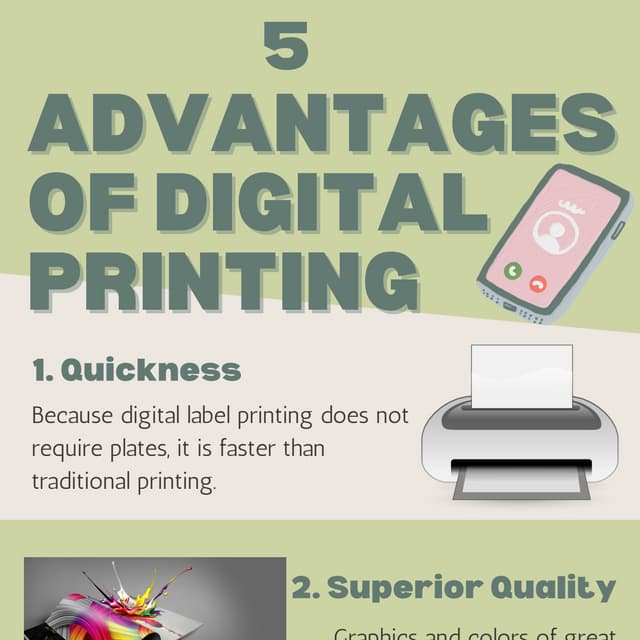Some Known Incorrect Statements About Digital Printing
Some Known Incorrect Statements About Digital Printing
Blog Article
The Ultimate Guide To Digital Printing
Table of ContentsExcitement About Digital PrintingFacts About Digital Printing UncoveredThe Basic Principles Of Digital Printing The Main Principles Of Digital Printing More About Digital PrintingDigital Printing for Dummies
Variable data printing, such as straight mail with personalized codes and addresses, is preferably suited for electronic printing. Digital fast printing only requires four steps of layout, evaluation, printing and binding to get whatever done. Digital fast printing has an unrivaled benefit: print on need.According to PMMI, electronic printing enables brands and suppliers to react rapidly to consumer demands while boosting the supply chain, reducing warehousing expense and waste, and appreciating faster time to market. That all sounds wonderful, but just how does this innovation do all that? The significant differentiator of these modern technologies is that there are no set up charges and no plates with digital printing.
Digital Printing - Questions
According to Wikipedia, the best distinction in between digital printing and typical methods such as lithography, flexography, gravure, or letterpress - Digital Printing is that there is no demand to change printing plates in electronic printing, whereas in these analog printing approaches the plates are repeatedly replaced. This causes quicker turn-around time and lowers price when utilizing electronic printing.
Digital printing is extremely adaptable, so it's simple to make adjustments to the package layout rapidly. It all goes back to the plates.
Extra inventory can suggest more waste later on. With standard printing approaches, short-run printing is just not feasible. Since a great style can make or damage your item, digital printing regularly produces high-quality, clear and vibrant graphics each time. Digital printing on adaptable bags includes the bright, vibrant, and accurate graphics that practically bid customers to get to out and touch them.
Digital printing is the process of printing digital-based photos directly onto a variety of media substratums. There is no need for a printing plate, unlike with balanced out printing. Digital files such as PDFs or desktop posting data can be sent out directly to the digital printing machine to publish on paper, picture paper, canvas, textile, synthetics, cardstock and various other substratums.
What Does Digital Printing Do?
According to PMMI, electronic printing allows brand names and manufacturers to react swiftly to customer needs while boosting the supply chain, minimizing warehousing cost and waste, and taking pleasure in faster time to market. That all noises excellent, but exactly how does this technology do all that? The major differentiator of these technologies is that there are no set up charges and no plates with digital printing.
According to Wikipedia, the biggest distinction between digital printing and standard methods such as lithography, flexography, gravure, or letterpress is that there is no requirement to change printing plates in electronic printing, whereas in these analog printing approaches the plates are repeatedly replaced. This leads to quicker turnaround time and reduces cost when making use of electronic printing.

The Buzz on Digital Printing
With traditional here are the findings printing approaches, short-run printing is simply not possible. Due to the fact that a great layout can make or damage your item, electronic printing constantly creates top notch, clear and vibrant graphics each time.

According to PMMI, digital printing permits brands and manufacturers to react rapidly to customer demands while enhancing the supply chain, reducing warehousing price and waste, and delighting in faster time to market. That all sounds terrific, but just how does this modern technology do all that? The significant differentiator of these innovations is that there are no set-up costs and no plates with electronic printing.
The smart Trick of Digital Printing That Nobody is Discussing
This results in quicker turnaround time and reduces price when making use of electronic printing.
Rapid manufacturing indicates obtaining your item to market much faster. It also suggests it's simpler and faster to make modifications in the future, when you change a recipe, add a SKU, or create pop over to this site seasonal packaging. Digital printing is extremely versatile, so it's simple to make modifications to the bundle style rapidly. Everything returns to home plates.

How Digital Printing can Save You Time, Stress, and Money.
Digital printing is the procedure of printing digital-based pictures straight onto a variety of media substrates. There is no demand for a printing plate, unlike with balanced out printing. Digital documents such as PDFs or desktop publishing documents can be sent directly to the electronic printing machine to publish on paper, image paper, canvas, material, synthetics, cardstock and other substratums.
Report this page